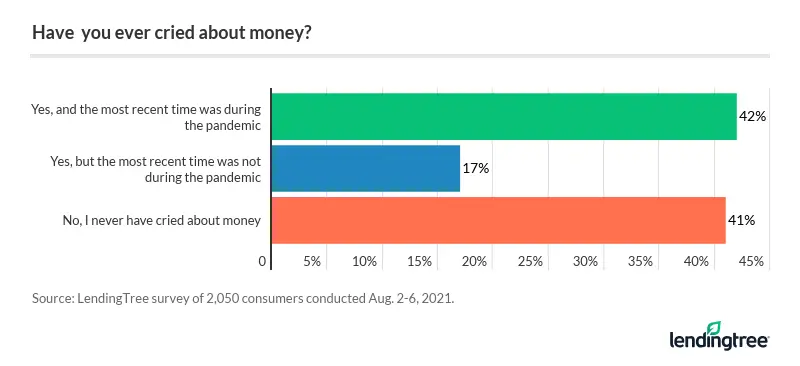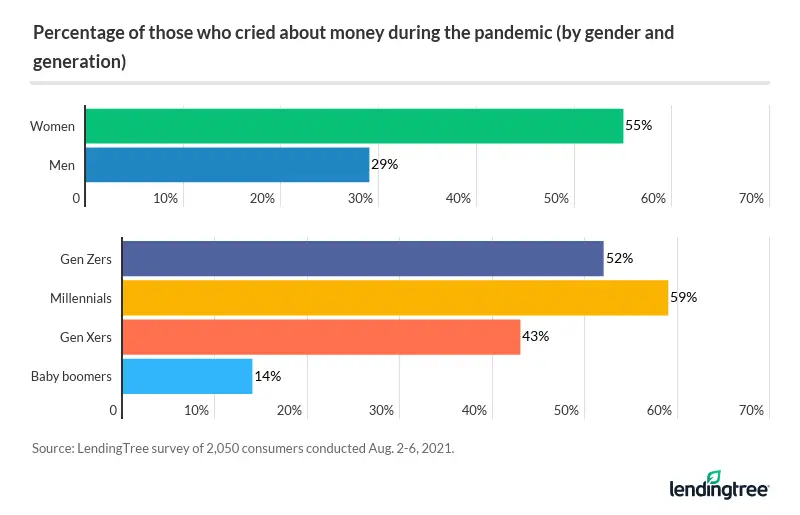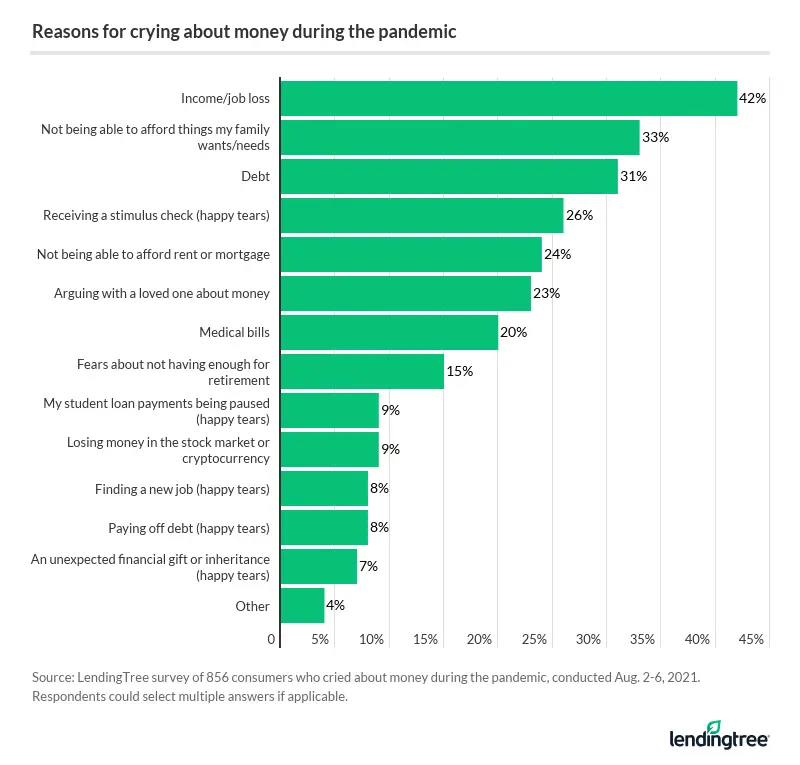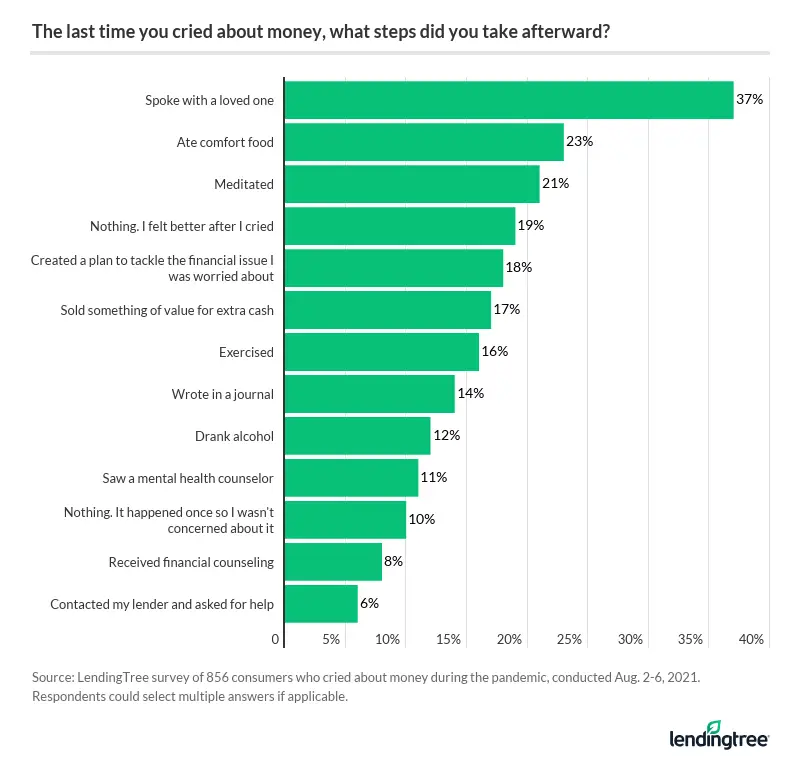42% of Americans Cried About Money During the Pandemic; Income Loss Most Common Reason
Since the coronavirus pandemic spread across the world in early 2020, there have been plenty of reasons to have a good cry. As it turns out, money is one of them.
More than 4 in 10 Americans admitted to shedding tears over their financial situation during the COVID-19 outbreak, according to our new survey of 2,050 U.S. consumers. Respondents identifying as parents with young children, women and millennials were the most likely groups to report crying over money.
Our survey also revealed specific causes of these crying sessions, from unhappiness over job losses to tears of joy from government relief such as the economic impact payments (also known as stimulus checks). Unfortunately, though, not all consumers followed this very human emotion by taking steps to improve their financial situation.
Key findings
- About twice as many women (55%) admitted to crying about money during the pandemic than did men (29%). Parents of children under 18 (60%) and millennials (59%) were also more likely to report shedding tears over money since March 2020.
- Job or income loss (42%) was the No. 1 cause for crying during the pandemic. Other top reasons were centered around affordability of needs and wants (33%) and facing debt (31%).
- Some consumers have had a “happy cry” during the pandemic, thanks to stimulus checks (26%) or paused student loan payments (9%), among other reasons.
- Few respondents took actionable steps after crying about money: Only 18% said they created a plan to tackle the financial issue they worried about, while 17% sold something of value for extra cash.

Parents, women and millennials more likely to cry over money
Overall, a full 42% of Americans have broken down about money over the past year-plus. But some groups seem more likely to have cried about their finances.
Parents of children under 18 were the most likely to report crying since March 2020. Many parents have carried an especially heavy burden during the pandemic. In some cases, for example, they have taken on multi-generation responsibilities: caring for elderly family members especially vulnerable to the coronavirus, while also managing the time of kids who were kept out of school.
Working parents also had to worry about their income, manage the family budget and sometimes handle debt repayment.
Crying wasn’t a one-time event, particularly for respondents identifying as female: 32% of women who cried about money during the pandemic said they wept at least five times, versus 15% of men who said the same.
Beyond gender differences, our survey results also showed stark splits among the various generations: Just 14% of baby boomers said they cried over money within the last 17 months, and within that group, about 32% cited fears of not having enough money saved for retirement.

Job losses, affordability and debt cause the most sorrow
The pandemic’s temporary economic shutdown, along with increased unemployment and accelerating inflation, have sparked financial challenges for many. But of course, not all Americans have suffered to the same degree.
Nearly half (47%) of survey respondents who make less than $35,000 said they cried about money during the pandemic, versus about 38% of respondents who earn $75,000 or above.
Federal government aid, such as economic impact payments, aimed to offer financial support where it was needed most. But relief didn’t always arrive in time — or in the right amount — for many U.S. residents who couldn’t afford their rent or mortgage payments or who faced food insecurity.
Regardless of income level, the top reasons for crying over money problems were job or income loss (42%), not being able to afford family wants or needs (33%) and debt repayment (31%).
Some consumers shed tears of joy, thanks to federal relief
As we all know, crying doesn’t necessarily mean you’ve got the blues. On the bright side of our survey findings, many of respondents said they shed “happy tears” at some point during the pandemic.
Thanks, in part, to a more open economy in 2021 and the continuation of government-sponsored coronavirus aid from 2020, there were at least a few reasons to weep with relief.
It’s also possible that consumers experienced both positive and upsetting emotions during the first year-plus of the pandemic: 84% of those who cried during the pandemic said they did so multiple times.

Turn your emotion into motivation and improve your finances
Financial challenges, from maintaining income to repaying debt, existed long before the COVID-19 outbreak. Then the coronavirus pandemic brought commerce to a standstill and made it even more difficult for many consumers to manage their cash flow. No wonder many of us have cried it out in 2020 and 2021.
The question is what to do about it. Having a good cry can be made better with some follow-up action. Unfortunately, though, few survey respondents said they made a change after becoming emotional about money.
Of those who reported crying during the pandemic:
- 18% created a plan to tackle the financial issue they were worried about
- 17% sold something of value for extra cash
- 8% sought out credit counseling
- 6% contacted their lender and asked for help
These are all positive steps to take once you’re done grabbing for the Kleenex box. It’s especially wise to ask for help, particularly from creditors or objective certified or licensed financial professionals. So instead of suffering in silence during the pandemic, ask around and work toward fixing what’s ailing you.

Methodology
LendingTree commissioned Qualtrics to conduct an online survey of 2,050 U.S. consumers from Aug. 2-6, 2021. The survey was administered using a non-probability-based sample, and quotas were used to ensure the sample base represented the overall population. All responses were reviewed by researchers for quality control.
We defined generations as the following ages in 2021:
- Generation Z: 18 to 24
- Millennial: 25 to 40
- Generation X: 41 to 55
- Baby boomer: 56 to 75
While the survey also included consumers from the silent generation (defined as those 76 and older), the sample size was too small to include findings related to that group in the generational breakdowns.
Get personal loan offers from up to 5 lenders in minutes
Read More
40% of Americans Cried About Money in Past Year — Including More Than Half of Millennials Updated August 16, 2022 According to the newest LendingTree survey, 4 in 10 adults — including more than half…Read More
No. 1 Source of Money Stress for Millennials Is Debt Updated March 13, 2018 A LendingTree survey reveals what millennials worry about the most when it comes to money….Read More

